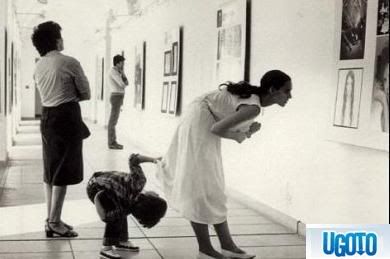Allegra Ravizza :: ART PROJECT
JOYS; Personale
On virtually every other building in Milan, there is some sort of graffiti scrawled on it - some well-scripted and visually appealing; others, not so much. Some consider it an art form while others call it an act of vandalism. Many argue that its the only way to keep a culture alive, to communicate important messages to the masses. Graffiti may be unconventional and unsolicited, but it does not disqualify it from being a kind of art, a kind of expression. Graffiti in every major citiy of the world is similiar, yet also different; each culture develops its own creativity and skills.
I first came across Allegra Ravizza Art Project during the opening night of their exhibition, entitled JOYS (the pen name of artist Cristian Bovo, Padova, 1974), on 24 May 2007. Due to the amount of people and the delicious bellinis served that night, it wasn't until weeks later that I went back to get a closer look at the art of this JOYS fellow.
My first reaction to the work of JOYS was how different his work was from the works I've seen at other gallery openings of the same genre (meaning, Contemporary Art). It was so refreshing to stand before art that thinks outside the box. To me, this man has taken (Italian) penmanship to the next level, where the forms remain attached together yet one is still able to make out what these letters are supposed to represent. His sculpture represents an eclectic but cool three-dimensional approach to graffiti, better known as "art on the wall" (in the case of this exhibition, since it is mounted on the walls). Bold colors of red, yellow, blue and purple grabbed my attention. These sculptures were far beyond what the human mind could comprehend, and although I did not immediately identify the works as "script", I did feel that they could jump off the wall at any given time. I felt that his works have overcome the confines of two-dimensional space and because each letter was so precise, geometrical and so perfect, knew that he must have been influenced by mathematics and probably the works of M.C. Escher.
I can see JOYS' sculptures being used as a means of not only communicating the need to be creative and the survival of a culture, but profound words and phrases with the ability to spread a message across, be it something political, cultural, social or religious. Art that has a purpose, which also has a presence, is much needed in our seemingly nihilistic urban environments.
Colorful pipes, anyone?










 This show, which comprises of 19 works of acrylic on canvas (1o of which are in a large format -195 x 230 cm), 6 acrylic collages on paper, 8 pastel designs on paper e 3 square cross-hatched designs on paper... exhibits the work of this German contemporary artist at its very best, while one can truly grasp where he is coming from. It is no wonder that when asked about one of his watercolors, Förg responded with the following quote:
This show, which comprises of 19 works of acrylic on canvas (1o of which are in a large format -195 x 230 cm), 6 acrylic collages on paper, 8 pastel designs on paper e 3 square cross-hatched designs on paper... exhibits the work of this German contemporary artist at its very best, while one can truly grasp where he is coming from. It is no wonder that when asked about one of his watercolors, Förg responded with the following quote:






